
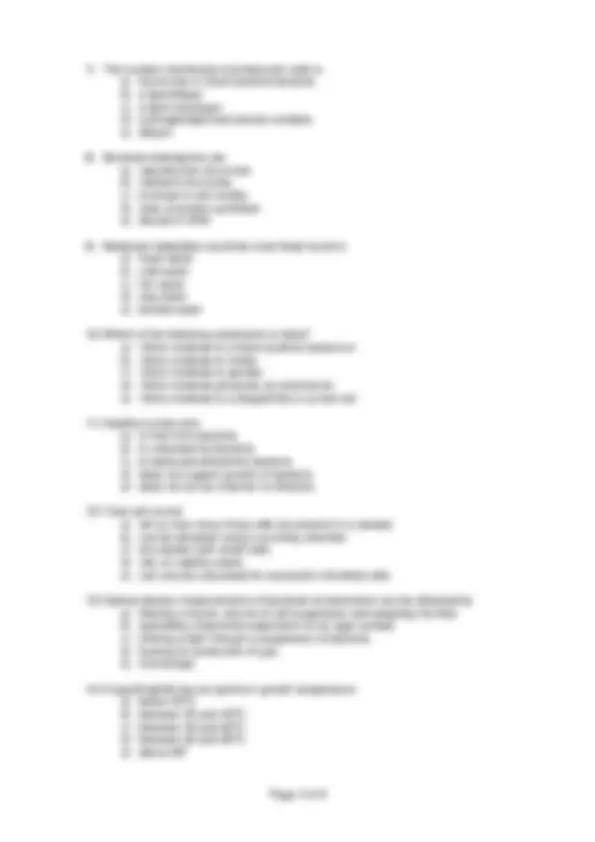
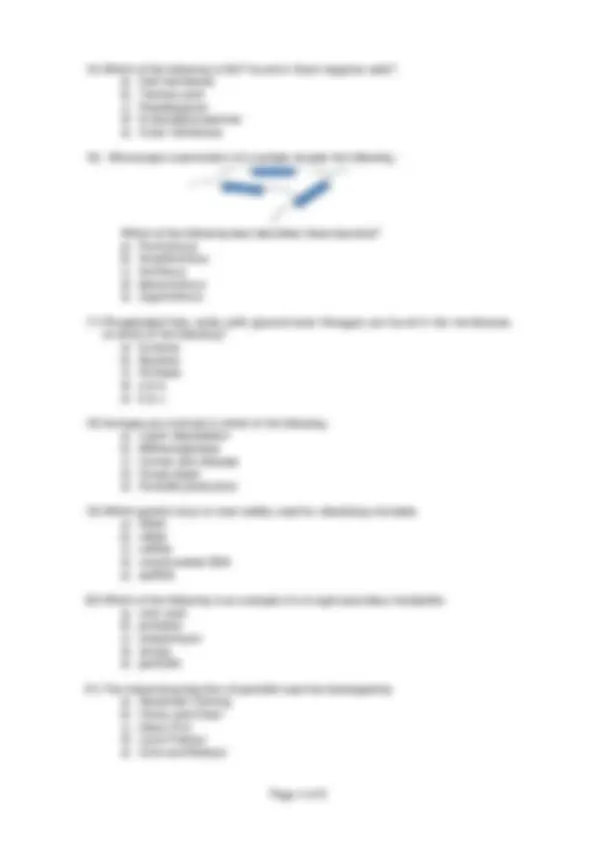
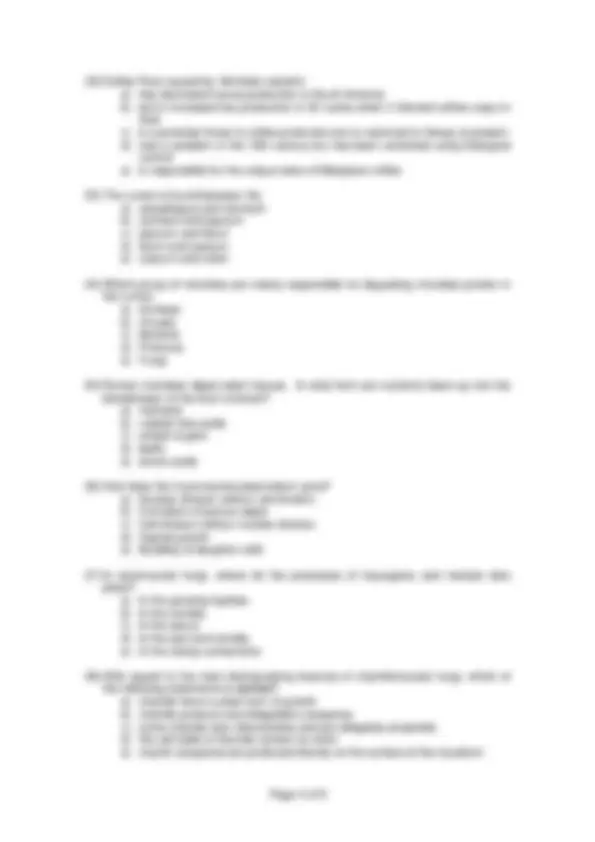
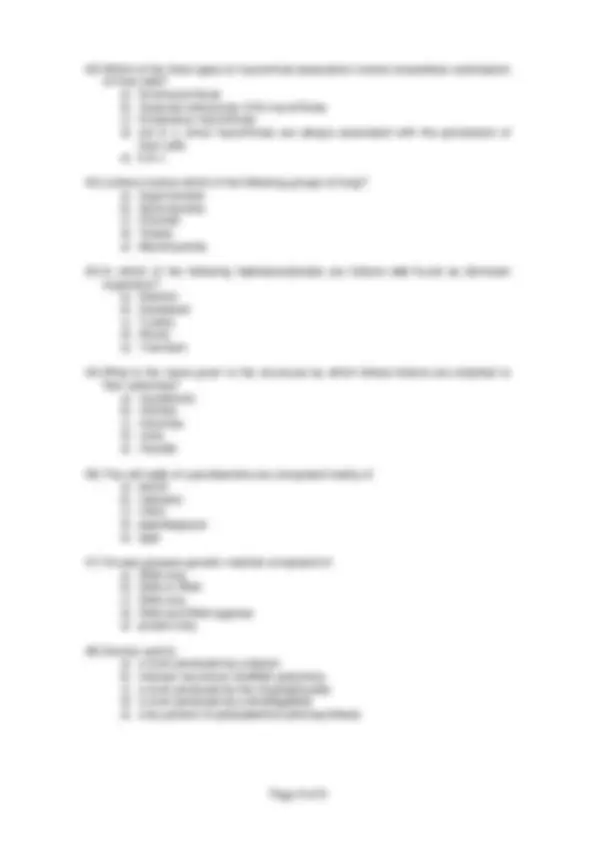
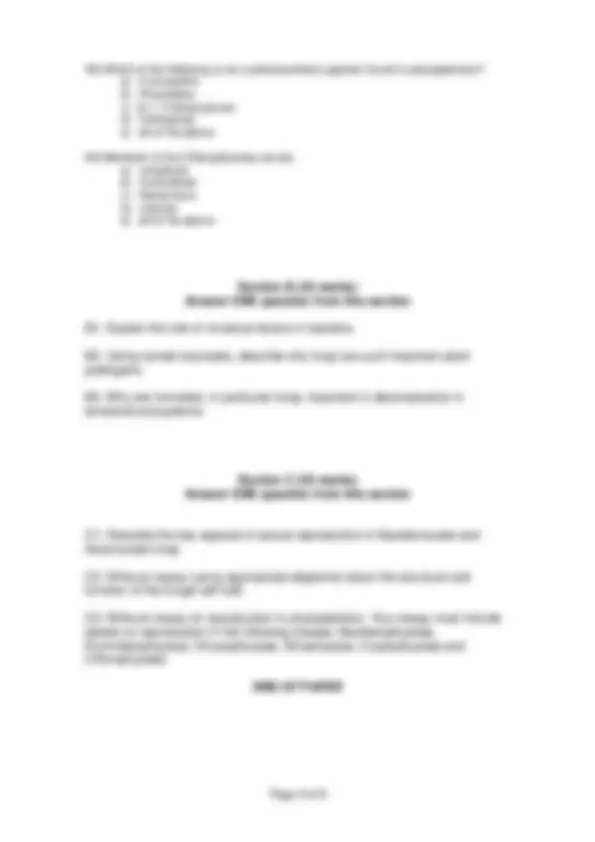


Study with the several resources on Docsity

Earn points by helping other students or get them with a premium plan


Prepare for your exams
Study with the several resources on Docsity

Earn points to download
Earn points by helping other students or get them with a premium plan
Community
Ask the community for help and clear up your study doubts
Discover the best universities in your country according to Docsity users
Free resources
Download our free guides on studying techniques, anxiety management strategies, and thesis advice from Docsity tutors
Exponential Phase Cells, Adapting To Their Environment, Producing Secondary Metabolites, Dividing Rapidly, Losing Viability Rapidly, Lacking Nutrients, Lipid Monolayer, Reproductive Structures, Sites of Protein Synthesis, Vibrio Cholerae. Past exam paper for biological courses are available here. I expect people will get some help if they need.
Typology: Exams
1 / 9

This page cannot be seen from the preview
Don't miss anything!






Section A (50 marks) Answer ALL questions
During exponential phase cells are a) adapting to their environment b) producing secondary metabolites c) dividing rapidly d) losing viability rapidly e) lacking nutrients.
Bacterium X has an optimum growth temperature of 30oC where it can double every 30 minutes. It can also survive at temperatures between 0 and 40oC. One hundred of these bacteria are inoculated into a flask and incubated at 30oC for one hour. The temperature is then increased to 50oC for one hour before being returned to 30oC for a further hour. Assuming the medium was optimal for growth and there was no lag phase how many bacteria would there be at the end of this experiment? a) 200 b) 300 c) 400 d) 800 e) 1600
The influenza virus a) replicates rapidly in complex growth medium b) has RNA as its genetic material c) only infects humans d) is an orbivirus e) has no surface antigens.
Microscopic observation of a sample reveals the following:-
Which of the following organisms is this most likely to be? a) Streptococcus mutans b) Escherichia coli c) Micrococcus luteus d) Bacillus anthracis e) Staphylococcus aureus
Which of the following statements is true? a) Mitochondria are often found in prokaryotic cells b) All prokaryotic cells have a cell wall c) Flagella are found only at the poles of prokaryotic cells d) All prokaryotic cells carry plasmids e) All prokaryotic cells have a cell membrane
The periplasmic space is a) found only in Gram positive bacteria b) found only in Gram negative bacteria c) found in all bacteria d) a component of the nucleoid e) a vacuole.
Which of the following is NOT found in Gram negative cells? a) Cell membrane b) Teichoic acid c) Peptidoglycan d) N-acetylglucosamine e) Outer membrane
Microscopic examination of a sample reveals the following:-
Which of the following best describes these bacteria? a) Peritrichous b) Amphitrichous c) Atrichous d) Monotrichous e) Zygotrichous
Phospholipid fatty acids (with glycerol-ester linkages) are found in the membranes of which of the following? a) Eukarya b) Bacteria c) Archaea d) a & b e) b & c
Archaea are involved in which of the following: a) Lignin degradation b) Methanogenesis c) Human skin disease d) Potato blight e) Penicillin production
Which genetic locus is most widely used for classifying microbes a) tRNA b) rRNA c) mRNA d) mitochondrial DNA e) dsRNA
Which of the following is an example of a fungal secondary metabolite. a) citric acid b) protease c) streptomycin d) tempe e) penicillin
The industrial production of penicillin was first developed by a) Alexander Fleming b) Florey and Chain c) Glaxo PLC d) Louis Pasteur e) Crick and Watson
22) Coffee Rust caused by Hemileia vastatrix a) has decimated cocoa production in South America b) led to increased tea production in Sri Lanka when it infected coffee crops in Asia c) is a potential threat to coffee production but is restricted to Kenya at present d) was a problem in the 19th century but has been contained using biological control e) is responsible for the unique taste of Malayisan coffee
The rumen is found between the a) oesophagus and stomach b) stomach and jejunum c) jejunum and ileum d) ileum and caecum e) caecum and colon
Which group of microbes are mainly responsible for degrading microbial protein in the rumen a) Archaea b) Viruses c) Bacteria d) Protozoa e) Fungi
Rumen microbes digest plant tissues. In what form are nutrients taken up into the bloodstream of the host ruminant? a) methane b) volatile fatty acids c) simple sugars d) lipids e) amino acids
How does the myxomycete plasmodium grow? a) Nuclear division without cell division. b) Formation of porous septa c) Cell division without nuclear division. d) Hyphal growth e) Budding of daughter cells
In ascomycete fungi, where do the processes of karyogamy and meiosis take place? a) In the growing hyphae. b) In the conidia. c) In the ascus. d) In the asci and conidia. e) In the clamp connections
With regard to the main distinguishing features of chytridiomycete fungi, which of the following statements is correct? a) chytrids have a yeast form of growth b) chytrids produce only biflagellate zoospores c) some chytrids lack mitochondria and are obligately anaerobic d) the cell walls of chytrids contain no chitin e) chytrid zoospores are produced directly on the surface of the mycelium
Which of the following descriptions Is unlikely to be characteristic of a fungus which relies on animals to disperse Its spores? a) production of odours b) production of zoospores c) growth in insect nests d) growth on dung e) sporulation on the anthers of a host plant
What is the name of the phenomenon whereby spores of some fungi do not germinate after dispersal until they receive a particular environmental stimulus? a) anastomosis b) positive phototropism c) dormancy d) negative phototropism e) indeterminacy
Which one of the following statements about the global carbon cycle is correct? a) All organisms need an external supply of organic carbon. b) In terrestrial systems the flow of carbon from the plant subsystem to the herbivore subsystem is greater than that to the decomposer subsystem. c) In terrestrial systems the flow of carbon from the plant subsystem to the decomposer subsystem is greater than that to the herbivore subsystem d) The decomposer susbsystem is composed only of microorganisms e) Fungi can fix atmospheric CO 2 and convert it to organic forms
Some fungal pathogens produce structures called haustoria during infection of the host. What Is the main function of these structures? a) to penetrate the host epidermis b) to kill host cells c) to facilitate dispersal by insect vectors d) to suppress the resistance response of the host e) to maximise the contact area with the host cell for nutrient uptake by the pathogen
Which of the following statements relating to Dutch Elm Disease caused by Ophiostoma ulmi Is untrue? a) toxins are produced by the fungus b) intracellular penetration of host cells c) insect vector involved d) a vascular wilt e) yeast-mycelial transition involved
Ectomycorrhizal fungi are generally found associated with which type of plant host? a) shrubs b) trees c) grasses d) most plants e) crop plants
Which of the three types of mycorrhizal association involve intracellular colonisation of host cells? a) Ectomycorrhizas b) Vesicular-arbuscular (VA) mycorrhizas c) Ericaceous mycorrhizas d) a,b & c, since mycorrhizas are always associated with the penetration of host cells e) b & c
Lichens involve which of the following groups of fungi? a) Zygomycetes b) Ascomycetes c) Chytrids d) Yeasts e) Mycomycetes
In which of the following habitats/substrata are lichens not found as dominant organisms? a) Deserts b) Grassland c) Tundra d) Rocks e) Tree bark
What is the name given to the structures by which foliose lichens are attached to their substrata? a) mycobionts b) rhizines c) rhizomes d) roots e) rhizoids
The cell walls of cyanobacteria are composed mainly of a) pectin b) cellulose c) chitin d) peptidoglycan e) agar
Viruses possess genetic material comprised of: a) RNA only b) DNA or RNA c) DNA only d) DNA and RNA together e) protein only
Domoic acid is: a) a toxin produced by a diatom b) induces neurotoxic shellfish poisoning c) a toxin produced by the Cryptophyceae d) a toxin produced by a dinoflagellate e) a by-product of phytoplankton photosynthesis